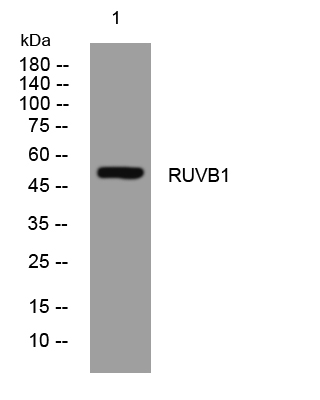RUVB1 rabbit pAb
- Catalog No.:YT7330
- Applications:WB
- Reactivity:Human;Mouse;Rat
- Target:
- RUVB1
- Fields:
- >>Wnt signaling pathway
- Gene Name:
- RUVBL1 INO80H NMP238 TIP49 TIP49A
- Protein Name:
- RUVB1
- Human Gene Id:
- 8607
- Human Swiss Prot No:
- Q9Y265
- Mouse Gene Id:
- 56505
- Mouse Swiss Prot No:
- P60122
- Rat Gene Id:
- 65137
- Rat Swiss Prot No:
- P60123
- Immunogen:
- Synthesized peptide derived from human RUVB1 AA range: 195-245
- Specificity:
- This antibody detects endogenous levels of RUVB1 at Human/Mouse/Rat
- Formulation:
- Liquid in PBS containing 50% glycerol, 0.5% BSA and 0.02% sodium azide.
- Source:
- Polyclonal, Rabbit,IgG
- Dilution:
- WB 1:500-2000
- Purification:
- The antibody was affinity-purified from rabbit antiserum by affinity-chromatography using epitope-specific immunogen.
- Concentration:
- 1 mg/ml
- Storage Stability:
- -15°C to -25°C/1 year(Do not lower than -25°C)
- Molecular Weight(Da):
- 50kD
- Background:
- This gene encodes a protein that has both DNA-dependent ATPase and DNA helicase activities and belongs to the ATPases associated with diverse cellular activities (AAA+) protein family. The encoded protein associates with several multisubunit transcriptional complexes and with protein complexes involved in both ATP-dependent remodeling and histone modification. Alternate splicing results in multiple transcript variants. [provided by RefSeq, Jan 2016],
- Function:
- domain:Binding to MYC is dependent on a Myc domain essential for oncogenic activity.,function:Essential for cell proliferation.,function:May be able to bind plasminogen at cell surface and enhance plasminogen activation.,function:Possesses single-stranded DNA-stimulated ATPase and ATP-dependent DNA helicase (3' to 5') activity. Component of the NuA4 histone acetyltransferase complex which is involved in transcriptional activation of select genes principally by acetylation of nucleosomal histones H4 and H2A. This modification may both alter nucleosome - DNA interactions and promote interaction of the modified histones with other proteins which positively regulate transcription. This complex may be required for the activation of transcriptional programs associated with oncogene and proto-oncogene mediated growth induction, tumor suppressor mediated growth arrest and replicative senescence,
- Subcellular Location:
- Nucleus matrix. Nucleus, nucleoplasm. Cytoplasm . Membrane . Cytoplasm, cytoskeleton, microtubule organizing center, centrosome. Dynein axonemal particle . Mainly localized in the nucleus, associated with nuclear matrix or in the nuclear cytosol, although it is also present in the cytoplasm and associated with the cell membranes. In prophase and prometaphase it is located at the centrosome and the branching microtubule spindles. After mitotic nuclear membrane disintigration it accumulates at the centrosome and sites of tubulin polymerization. As cells pass through metaphase and into telophase it is located close to the centrosome at the early phase of tubulin polymerization. In anaphase it accumulates at the zone of tubule interdigitation. In telophase it is found at polar tubule overlap,
- Expression:
- Ubiquitously expressed with high expression in heart, skeletal muscle and testis.
- June 19-2018
- WESTERN IMMUNOBLOTTING PROTOCOL
- June 19-2018
- IMMUNOHISTOCHEMISTRY-PARAFFIN PROTOCOL
- June 19-2018
- IMMUNOFLUORESCENCE PROTOCOL
- September 08-2020
- FLOW-CYTOMEYRT-PROTOCOL
- May 20-2022
- Cell-Based ELISA│解您多样本WB检测之困扰
- July 13-2018
- CELL-BASED-ELISA-PROTOCOL-FOR-ACETYL-PROTEIN
- July 13-2018
- CELL-BASED-ELISA-PROTOCOL-FOR-PHOSPHO-PROTEIN
- July 13-2018
- Antibody-FAQs
- Products Images

- Western blot analysis of lysates from MCF-7 cells, primary antibody was diluted at 1:1000, 4°over night



